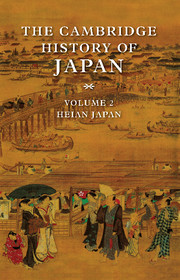Book contents
- Frontmatter
- Introduction
- 1 The Heian court, 794–1070
- 2 The capital and its society
- 3 Land and society
- 4 Provincial administration and land tenure in early Heian
- 5 Chinese learning and intellectual life
- 6 Aristocratic culture
- 7 Aristocratic Buddhism
- 8 Religious practices
- 9 Insei
- 10 The rise of the warriors
- Works cited
- Glossary-index
- Japan in the Heian period"
- References
1 - The Heian court, 794–1070
Published online by Cambridge University Press: 28 March 2008
- Frontmatter
- Introduction
- 1 The Heian court, 794–1070
- 2 The capital and its society
- 3 Land and society
- 4 Provincial administration and land tenure in early Heian
- 5 Chinese learning and intellectual life
- 6 Aristocratic culture
- 7 Aristocratic Buddhism
- 8 Religious practices
- 9 Insei
- 10 The rise of the warriors
- Works cited
- Glossary-index
- Japan in the Heian period"
- References
Summary
KAMMU TO NIMMYŌ, 781–850
The man known to history as Emperor Kammu (737–806, r. 781–806) was an obscure official in his mid-thirties when the exigencies of Nara politics catapulted his almost equally obscure father, Kōnin (702–82, r. 770–81), onto the imperial throne in 770 and elevated Kammu himself to the position of crown prince three years later. In 781 his father abdicated, and the former director of the state Academy, who may have been passed over originally in the selection of Kōnin's heir apparent because of the humble immigrant origins of his mother's patriline (a Korean-descended lineage, the Yamato), now found himself installed as Emperor of Japan – a learned peer of his illiterate contemporary Charlemagne and of the famous Abassid caliph Harun Al-Rashid at the new capital of Baghdad. Governmental reform and retrenchment, coupled with vigorous action against Buddhist and secular opponents, had laid a sound basis for imperial power during Könin's reign, and Kammu quickly demonstrated that he was capable of exercising and enhancing that power.
After efficiently suppressing a plot against the throne in 782 by high-ranking adherents of the imperial lineage displaced by Könin's accession (the line of Emperor Temmu), the new emperor and his advisers apparently decided the time had come to leave the capital, which was the handiwork of the old imperial line and the stronghold of both that line's adherents and the Buddhist forces that seem to have very nearly succeeded in usurping imperial authority in the time of Kōnin's immediate predecessor, Empress Shōtoku (718–70; r. 749–58, 764–70).
Keywords
- Type
- Chapter
- Information
- The Cambridge History of Japan , pp. 20 - 96Publisher: Cambridge University PressPrint publication year: 1999
References
- 8
- Cited by



